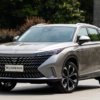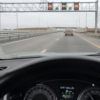The Automatic Lane Change function will appear on 15 models in 33 European countries, and it can be activated by updating the firmware. The system will be able to operate at speeds of 80-140 kilometers per hour, but only on certain highways. The electronics itself will give the command to change lanes for overtaking and will return the car back after completing the maneuver, and will also help you not to miss the desired exit or junction.
The list of Mercedes assistance systems released no earlier than January 2023 will be supplemented with the Automatic Lane Change (ALC) function. In total, 15 models in 33 countries will receive it, and the system can be activated on already sold cars through a firmware update. From September, owners of Mercedes-Benz C-Class, E-Class, S-Class, GLC, CLE, EQE, EQS, EQS SUV, as well as EQE SUV will be able to take advantage of the innovation – according to company estimates, this is about 200 thousand cars.
Mercedes-Benz The new Mercedes-Benz E-Class now has a 1.5 engine: very expensive
The Automatic Lane Change function depends on two active assistants – Active Steering Assist and Active Distance Assist Distronic. With active cruise control, the electronics will automatically change lanes to overtake the car in front, and if a route has been set in the navigation, the car will change lanes in advance before the desired junction or exit. Automatic lane change is available at speeds of 80-140 kilometers per hour and only on certain highways with clearly readable markings. And since this is not a full-fledged autopilot, but only a Level 2 system, the driver must always keep an eye on the road.
 Mercedes-Benz Presents the first Mercedes-Benz model from the Mythos collection line
Mercedes-Benz Presents the first Mercedes-Benz model from the Mythos collection line
The automated control system of the third level of autonomy, which Mercedes-Benz has certified in Germany and the USA, is less demanding of humans, but also works only on certain sections of highways and within one lane. Mandatory conditions: heavy traffic, speed no higher than 64 kilometers per hour, absence of emergency vehicles nearby, so that it is daylight, good weather and there are no interchanges along the route. The system receives data from sensors of the driver assistance complex, lidar in the radiator grille, cameras, microphones and even a road humidity sensor. In the next models, the Germans will begin to use a different autopilot – based on the technologies of the Chinese startup Momenta.
Nothing sacred: particularly sophisticated tuning of the G-Class







